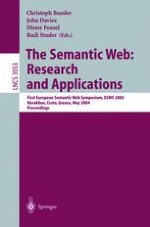2004 | Buch
The Semantic Web: Research and Applications
First European Semantic Web Symposium, ESWS 2004 Heraklion, Crete, Greece, May 10-12, 2004. Proceedings
herausgegeben von: Christoph J. Bussler, John Davies, Dieter Fensel, Rudi Studer
Verlag: Springer Berlin Heidelberg
Buchreihe : Lecture Notes in Computer Science
Enthalten in: Professional Book Archive
